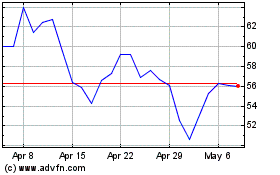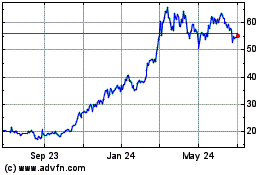Double Stock-Market Bubble Brings Toil and (Perhaps) Trouble
January 03 2021 - 10:29AM
Dow Jones News
By James Mackintosh
It is easy to spot bubbles. Too easy: They seem to be almost
everywhere, almost all the time. Worse still for those of us who
try to spot excess, much of the stuff that was labeled frothy in
recent years went on to make big money in 2020 for those who bought
into it anyway.
The question for investors: Were the bubble calls just wrong? Or
are we in a new era of wild speculation driven by cheap money that
must inevitably come to an end?
I lean toward the latter. But the stunning performance of so
many bubble stocks this past year shows that even if this turns out
to be right eventually, there is plenty of scope to be horribly
wrong in the meantime.
For one example, consider the bubble portfolio created in
mid-2017 by Paul McNamara, an emerging-market fund manager at GAM.
Featuring stocks and bonds labeled as bubbles by the financial
Twitter community that year, it includes Tesla, Netflix, Tencent, a
bitcoin fund, Canadian apartments, London property and long-dated
U.S., Japanese and Argentinian bonds. Only one -- the Argentinian
100-year bond -- is down since being selected, having lost almost
all its value.
If you had spread $900 equally across the portfolio's nine
holdings at the end of June 2017, you would now have more than
$2,950, more than double what you would have got from the S&P
500. Remember, this was buying the stuff that many thought was
already wildly overvalued.
Yet, the bubble-watchers were right on many of the stocks. Just
not for long. Parts of Mr. McNamara's bubble portfolio appeared to
burst, but then came roaring back in 2020. If there is a bubble, it
is a double bubble.
The Grayscale Bitcoin Trust, which holds bitcoin for a 2% fee,
dropped 90% from its 2017 peak, but in 2020 it almost quadrupled to
again trade above the value of the bitcoin it holds.
Tesla stock was below its mid-2017 price for most of the next 2
1/2 years amid fights with regulators, fears about a cash shortage
and missed production targets. Then it was electrified by the
events of 2020, rising eightfold to become one of the largest
companies in the world by market value.
Netflix and China's Tencent didn't reach their 2018 peaks again
until they were boosted by lockdowns and cheap money on their way
to a spectacular 2020.
Even some of the stocks that went through their own mini-bubbles
and busts earlier in the decade returned to form last year.
The 2013 fad for 3-D printing turned out to be pure froth, and
the leading exponent, 3D Systems, is down 89% from its high. In
2020, it rose 20%, outpacing the S&P.
The 2011 excitement about rare-earth elements gave birth to the
VanEck Vectors Rare Earth/Strategic Metals ETF. It is down 81% from
that year's high, but gained 63% in 2020.
Solar collapsed with oil during the 2008 financial crisis, but
was still frothy at the start of 2010. The Invesco Solar ETF
(amusing ticker alert: TAN) fell 81% from 2010's high, which was
already down more than half from its pre-financial crisis high.
This past year it more than tripled.
Cheap money often fuels speculative fervor, and this time has
been helped by bored work-from-homers finding that day trading is a
way to gamble their stimulus checks.
As usual the bubble stocks have a good story to tell about new
technology and major shifts in consumption. They are helped by the
superlow bond yields engineered by central banks. But their
valuations and the scale of the price moves are extreme and
probably unsustainable.
Probably. The danger for those of us calling out frothy markets
isn't only that high prices could be justified by fast-growing
profits, but that bubbles can always become more extreme. If you
doubt that, just look at 2020.
Write to James Mackintosh at James.Mackintosh@wsj.com
(END) Dow Jones Newswires
January 03, 2021 10:14 ET (15:14 GMT)
Copyright (c) 2021 Dow Jones & Company, Inc.
Grayscale Bitcoin Trust ... (AMEX:GBTC)
Historical Stock Chart
From Mar 2024 to Apr 2024

Grayscale Bitcoin Trust ... (AMEX:GBTC)
Historical Stock Chart
From Apr 2023 to Apr 2024
